
In this episode of CFO Weekly, Jacob Moelter, Chief Operating Officer and Chief Financial Officer at SupportNinja, joins Megan Weis to explore the role of the CFO in customer experience and how they are transforming it from a cost center into a strategic growth lever. Jacob brings extensive experience in finance and operations across public and private companies, with a deep background in investor relations, FP&A, and outsourcing services.
With his unique perspective on connecting financial metrics to customer outcomes, Jacob shares how finance leaders can leverage data to drive retention, improve unit economics, and design hybrid AI-human service models that balance efficiency with empathy. Currently serving as COO and CFO at SupportNinja, Jacob oversees the strategic evolution of omnichannel support solutions that help fast-growing companies elevate their customer experience while driving measurable financial returns.
Show/Hide Transcript
Megan - 0:50: Today, my guest is Jacob Molter. Jacob is a hands-on finance and operations leader with experience in various strategic and operational financial roles in public and private companies. Jacob has a track record of value creation, growing early stage organizations, and optimizing mature businesses through establishment and tracking of short and long term plans, establishing cost control measures, and creating and monitoring KPIs. Jacob is Chief Operating Officer and Chief Financial Officer at SupportNinja. SupportNinja provides best-in-class omnichannel support and customer experience solutions. SupportNinja's vision is to show the world a better way to outsource by developing the best people, implementing the latest technology, and challenging the status quo. Jacob, it's great to have you with us today.
Jacob - 1:40: Thanks for having me on. Really looking forward to chatting with you.
Megan - 1:42: Yeah. Me too. So over the years, you've seen the role of the CFO evolve far beyond financial stewardship from keeping score to actually shaping how companies grow, serve, and retain their customers. You've been at the forefront of that shift showing how finance can play a pivotal role in driving customer experience and revenue outcomes. So to start us off, was there a moment that made you realize that CFOs could do more than manage finances, that they could actively shape the customer experience and drive growth through it?
Jacob - 2:13: Yeah. Great question. I'm not sure there was like a single moment. I think it's something that has evolved over time. I've spent a lot of my career in services and outsourcing businesses where we work hand in hand with clients. And so I think if you look back historically, CX or customer experience was treated purely as a cost center. How can we make it more efficient? How can we deflect more volume? How can we buy more cost-effective labor? But over the years, I think we started to see a lot of data and how this has changed over time where it shows how powerful customer experience can be in driving overall unit economics. Right? Increasing lifetime value, improving retention, and how those improvements in those measurements can allow companies to invest further in accelerating growth. And that's I think for me, when it really clicked that finance leaders have a much broader role to play in this. That's what I love about the finance role and that really sits in the intersection of every function. Strong finance leaders can connect the dots between what's happening in operations or CX and sales and customer success, all these really important revenue-generating and operating groups that all the activities translate ultimately into financial performance. And, you know, every business has its own drivers depending on whatever industry, and our job as CFOs or heads of finance is really to define what those levers are and help influence them, not just measure them. And I think that's important. You know, that philosophy is really shaped how we operate. We work with fast-growing companies to help them elevate their customer experience because for many of these companies, you know, they're small and medium-sized businesses, they're fast-growing, they're nimble. CX really isn't a core competency of theirs. And so when I stepped into the CFO role, one of the things that I implemented first and made it a point of for our leadership team is to make sure that we're joining two client business reviews a week. And I think for us, it really changed a lot in how we understand how clients are viewing things. We began identifying ways to help clients improve their own performance and not just ours. And I think that ultimately strengthened partnerships that we have with our clients and directly translated actually into better retention and growth for SupportNinja. And so I think, for me, it's in this industry, it's become very clear that sustainable financial success really requires investment in customer experience. I think those two things are inseparable.
Megan - 4:27: So before we get into the meat of the conversation, let's just take a step back for a second. Can you walk us through your career, how you got to where you are today, and tell us a little bit about SupportNinja?
Jacob - 4:37: So I started my career actually in investor relations where I worked with a number of pre-IPO or companies that had just gone public and helping their leadership team articulate the story to the investment community. And that was a really great role for me. I got to learn a number of different really high-profile type companies, their business models, and how to translate those models into what investors are looking at in terms of their thesis and how they make investment decisions. So I really love that opportunity to be able to help companies communicate their strategy and competitive landscape and all these things to buy-side and sell-side investors. And so, actually, I ended up really loving that role, but I wanted to be more of how do we help drive decisions versus just communicate those decisions once they're made? How can I help create the sausage versus just communicating that to investors? And so I ended up joining a company, Paylease, down in San Diego in their internal FP&A department. And that was a really great opportunity where I got firsthand understanding, looking at things like lifetime value and customer acquisition costs and really helping look at the overall some of these metrics and how they influence the success of the company in the future. And so from that point, me personally, I really like to get involved operationally and understand the models, understand the drivers, understand how we can influence them and really try to drive that partnership. And that's been my philosophy throughout my career. I ended up joining a company called support.com, which is another outsourcing company and really helped drive a lot of different things there where I manage both the investor relations function as well as their FP&A. And then got a opportunity to SupportNinja where I'm at currently and that's been a really great opportunity for me where we've been able to drive a meaningful amount of growth, you know, both organically and inorganically. We've expanded into multiple geos. And so I think one of the things that I've really enjoyed about my career is that I've been in a couple of different types of industries, but I think my the one thing that I bring back and center my approach around is connecting with leaders at the organization, understanding the drivers, and being able to tell that story and help them connect the work that they do to the overall financial success of the company.
Megan - 6:48: And I want to dive into one of the hottest topics shaping CX today, and that is, of course, AI. It's often framed as a job replacer, especially in customer service. But what have you seen that challenges that narrative and actually creates a skills premium for human agents for interactions?
Jacob - 7:06: There's definitely the scary headline. Right? AI is coming for your job. And I think, you know, to be fair, in some cases, we will see that play out. Certain low-complexity or repetitive tasks, I think, are going to be handled faster and more effectively by AI or agentic AI systems. But the really interesting thing that we're seeing firsthand is that story doesn't end there. First, AI needs to be managed, reviewed, trained, so, you know, it doesn't run itself. And that creates higher-skill opportunities for people who understand context, nuance, and how to ensure AI is performing as intended. Second, I think when companies do use AI to resolve simpler inquiries, they're not necessarily cutting headcount. Many are actually reinvesting the savings that they're driving by leveraging AI and upskilling or reprofiling their team members to focus on high-value work that's directly tied to their business goals like proactive outreach or retention or revenue-generating CX activities. And I think one of the last things that we're seeing is some of the most forward-thinking companies really understand that in customer experience, you can't necessarily automate empathy. And I think in many cases, customers still want the option to reach a real person, especially when something matters deeply to them. That human connection builds trust and loyalty in a way that for now, technology can't simply replicate. And so I think what we're seeing is a shift not from humans versus AI, but humans with AI. And the humans of the future will need to be more skilled and more analytical and more empathetic and focusing on complex high-impact interactions that I think truly end up driving value to the company.
Megan - 8:39: Yeah. I'm with you. I think in the short term, AI, it's going to take the place of a lot of work that's done today, but it's going to evolve the way work is done and the jobs that people have, and I think ultimately make them a lot more interesting.
Jacob - 8:53: Yeah. 100% agree.
Megan - 8:55: So once CFOs start thinking about CX as a growth lever, the next big question becomes how to quantify it. So can you walk us through how finance leaders can evaluate the unit economics of service and understand when and where to invest in CX improvements?
Jacob - 9:11: So I think it always starts with data, but more importantly, being able to connect the dots between that data and business outcomes. That'll be a couple of examples of how we've thought about it and how we've seen it in reality where you might have a technical customer success, technical CX team that's supporting a complex product. And on paper, one of those key metrics that often companies will measure is first contact resolution. You know, can we solve issue in a single touch? But if you dig a little bit deeper, you might find that that metric is actually driving the wrong behavior. Or, like, complex products, agents may be prematurely closing tickets just to hit their KPIs and that could ultimately be hurting retention. So I think it's critical not just to understand the metric, but the behavior that it drives and how that connects to your core unit economics. And from there, you want to look at, you know, where that team sits in the customer journey. Are they focused primarily on retention? Do they have opportunities to upsell or cross-sell without disrupting the client experience? Why are customers leaving and at what point in the journey are they leaving? Those answers will help inform where finance leaders should invest. And at SupportNinja, we take that analysis and we translate it into action. We'll use those insights to make recommendations to our clients and then often pilot initiatives that could drive positive outcomes. Like I said, most of our clients are small to mid-sized companies, so they value that we can deliver end-to-end CX solutions but still move quickly without the bureaucracy or change orders that slow bigger providers down. And give you an example, we have a streaming service for small businesses as a client, and this connects to our earlier point about, you know, how AI and CX can work together. We analyze their support data. We saw a lot of recurring inquiries that were around billing, deactivations, or you know, general product questions. And so with this team, we were able to implement a structured knowledge base and agent assist tools that improved efficiencies and the way that we were communicating with their end users so that we can match the client's brand voice and that freed up actually capacity for our team to do proactive outreach to low utilization customers that were at risk of churning. And so what we saw is utilization went up, churn went down, and we were able to prove out to their executive team that this cost-focused support function was now actually driving revenue and, you know, so I think we end up turning cost center into a profit center. And so when I think about evaluating unit economics, particularly in CX, it's really about what's that North Star metric, you know, is that retention? Is it revenue? Is it lifetime value? Or whatever it may be, and then identifying those initiatives that can meaningfully move those metrics. And I think that's where finance leaders are uniquely positioned to quantify that connection, and I think that's where the real opportunity lies.
Megan - 11:55: So I'm curious. You mentioned that small to medium-sized businesses are the sweet spot for SupportNinja, but what industries? Like, what is your ideal client?
Jacob - 12:06: Yeah. For us, it is customers that typically care deeply about their overall customer experience. Right? And I think that's where companies, you know, don't necessarily want to deflect as much volume as possible. Right? They really care and they understand the value that CX can provide, and I think that's where we found the most interesting types of clients that are having a lot of success. And so I wouldn't necessarily say it's industry-specific. We do see a lot probably the vast majority of our clients are SaaS companies and e-commerce. They probably make up about 70% of our overall revenue. And so we often find those customers care deeply about their customers and the experience that they have, and they're looking for a partner that can evolve quickly, that can test different things, and bring initiatives to them that will help them elevate their customer experience. I'll give you another really cool example. We had an e-commerce company that sold sports-themed apparel, and they were a very vibrant e-commerce company. They had a very unique personality to them. They're very confident. They were solution-oriented. They had a very unique brand voice. And it was a very small customer support organization, and we enabled that team with an agent copilot that was trained on their brand voice, and we were able to now actually inject unique flair into every interaction that we had with their customers. You know, we can actually if they bought an Ohio State sweater and they had questions on it, we can end that interaction with Oh and encourage like a really fun Ohio, you know, interaction to end. And so I think for us, like, you know, we can bring those opportunities and bring those ideas to companies at very minimal cost and sometimes no additional cost of ways that we can help them scale their team and improve their team in a way that they may not be able to do with just people alone.
Megan - 13:48: And when it comes to making investment decisions, CFOs, obviously, they need a clear framework. So what have you found to be most effective for prioritizing CX investments based on maybe marginal ROI or cost to serve? What kind of KPIs or return on investment? Like, how do you measure that?
Jacob - 14:08: Yeah. So when I put my CFO head on, I like to think about CX investments in the same way that we would any capital allocation decision. The challenge is that CX often has both direct and indirect returns, and so you need a framework that can capture both of those elements. And for us, internally, we typically have a three-step approach, which we've also found that resonates with clients when we make recommendations and put it in this format. But those steps are diagnose, quantify, and then test and scale. So for diagnose, we identify what pain points are across the customer journey. Are they high contact drivers, repeat issues, points of friction that correlate with churn or with low net promoter scores. And we look at the true cost to serve by segment. As an example, if it costs $12 per contact for one issue type and $4 for another, are those aligned with customer lifetime values of those segments? And so that can help first define where inefficiencies or opportunities exist. And then second, quantify. This is where finance and CX meet. You know, we model the potential ROI. What's the expected uplift in retention or conversion or efficiency if we make this change? You know, sometimes it's direct, like reducing handle time through better tooling. Sometimes it's indirect, like improving CSAT and seeing downstream lifetime value growth. And then finally, test and scale. So before rolling out a full program, we like to pilot those programs with, you know, within a small client segment or within a small region, and we validate that business case. And if the results are there, we scale it. And if not, we refine and test again.
Megan - 15:42: And you touched on this just a bit, but we're seeing the rise of hybrid AI-human service models. So how are leading brands structuring their teams, and what roles do CFOs play in designing them for both efficiency and human empathy?
Jacob - 15:57: Yeah. This is interesting. I think what we're seeing with some of the most forward-thinking brands is that they design human-plus-AI solutions where, you know, AI can either handle or assist with high-volume, low-complexity interactions, and humans focus on the higher-value, higher-context type work. And that structure typically is like a layered system, if you will. You know, AI and automation manage tier zero or tier one tasks like FAQs or where's my order, basic troubleshooting, which can often be powered by conversational bots or knowledge bases or agentic AI. And then humans, human agents, human customer support folks, they'll handle the more nuanced or emotionally charged or multi-variable interactions, the ones that require empathy or judgment or creative problem-solving. And then sitting above that is a control layer where, you know, smaller, more specialized group of humans who monitor and train and continuously improve the AI systems. And, you know, these are new roles that didn't exist five years ago where prompt engineers, it's CX analysts, it's AI trainers. And so I think it's really interesting how that's all playing out. And from CFO's perspective, the structure has massive implications, not just cost optimization, but like we've talked about from a value creation standpoint. And our job as CFO is to help model that right balance between automation and human touch. So we're not just actually saving cost, but we're actually improving outcomes like NPS or retention and resolution speed. And here at, you know, at SupportNinja, for example, we can help clients analyze that ROI curve. You know, what happens as you move one layer of work from humans to AI? Where does that marginal benefit flatten out or even decline because the experience quality drops? And that's where I think the CFO lens becomes really critical. It's about designing financially efficient yet customer-centric operating model. And we're starting to see CFO shift from negotiating approval of CX budgets and technology spend to helping co-architect these models, these hybrid models with, you know, operations and digital leaders. We're seeing the same exact question that you asked. What's that incremental ROI of automating this task? What's the opportunity cost of losing the human element here? How do we redeploy the savings to upskill teams or reinvest in customer growth? And my view is that hybrid AI-human teams work best when finance isn't just in the back office, but it's actively helping shape that design, ensuring that right balance between efficiency, experience, and long-term business impact.
Megan - 18:31: It's fascinating to see how finance leaders are rethinking the entire paradigm moving from just viewing CX budgets as cost centers to real revenue drivers.
Jacob - 18:41: Yeah.
Megan - 18:41: So from your experience, what triggered that mind shift, and what are the biggest challenges that CFOs face in integrating financial insights with customer journey design?
Jacob - 18:53: Yeah. I think, like you mentioned, for a long time, CX was viewed almost exclusively as a cost center, and it's something you had to fund to keep customers satisfied and operations running smoothly. And the finance conversation historically was largely about how do we make this less expensive, you know, but that's I think that's really changed dramatically over the past few years. And I think part of that big shift has come from data. Right? We now have the ability directly measure how customer experience impacts financial metrics like retention and lifetime value. And once you can quantify that link, I think it changes everything. You know, CX stops being an expense line and becomes an investment with measurable ROI. We can help clients that see that improving response time or personalization doesn't just lift CSAT. It helps reduce churn and increases net revenue retention. And we've seen cases where leveraging AI to automate simpler tasks like we talked about, frees up human agents to focus on proactive outreach and upselling, which drives incremental revenue. And so I think from a CFO perspective, that's the turning point. You start to ask, you know, what is the return on this CX initiative rather than what does it cost? And when you model this way, when you see, you know, 1% improvement in retention can mean, you know, in some cases, millions in incremental recurring revenue, I think that reframes that conversation entirely. And so I think I'd say the modern CFO's role has really evolved from gatekeeper to growth architect. And in my view, their job isn't necessarily just to control spend, it's to ensure that every dollar we invest, especially in CX, is directly tied to better customer outcomes. And in those cases, those outcomes can drive sustainable financial growth.
Megan - 20:27: And as we look ahead, the CFO sphere of influence continues to expand from financial strategy to culture, customer, and talent. So looking out over the next five to ten years, if we can even imagine what that's going to be, how do you see the CFO role evolving even further? And what new skills or mindsets will be critical as finance leaders become architects of both growth and experience?
Jacob - 20:53: Great question. And I wish I had a crystal ball. But I do think the CFO role is evolving faster now than at any point, you know, in the last few decades. Previously, it used to be about reporting accuracy or cost control, and now it's really about helping shape where the company is going and how it gets there. And I think that the modern CFO has become the translator between data and strategy and culture. And so I think over the next five to ten years, you'll see CFOs take a much more active role in areas like customer experience, digital transformation, or even talent strategy. As automation and AI reshape how we work, finance leaders will be really critical in determining where to deploy capital, but also how to redeploy people. And I think it takes both financial acumen and a deep understanding of human behavior and organizational design. And so I think the skills that will matter most will be around storytelling with data, cross-functional collaboration and adaptability. The CFO, you know, in the future needs to be as comfortable in a product or CX meeting as in a boardroom and helping connect how every decision impacts long-term value creation. And I think, you know, the mindset is just as important. The best CFOs will continue to be curious and creative and comfortable with ambiguity and I think they'll act less like auditors and more like architects, you know, helping design business models that balance those elements, efficiency, innovation, and culture.
Megan - 22:15: Jacob, thank you so much for your time today.
Jacob - 22:18: Thank you, Megan. It was really a pleasure chatting and looking forward to staying in touch.
Megan - 22:22: Yeah. I appreciate you being here today to share your insights, and this has been such a thoughtful and interesting conversation. Thank you again.
What You'll Learn:
-
Why CFOs must view customer experience as a revenue driver rather than just a cost center
-
How to quantify the ROI of CX investments using unit economics and customer journey analysis
-
Strategies for designing hybrid AI-human service models that optimize both efficiency and empathy
-
The critical metrics CFOs should track to connect CX improvements to financial performance
-
How AI is creating a skills premium for human agents rather than replacing them
-
The future of the CFO role as architect of growth, experience, and organizational design
Key Takeaways:
CFO as Customer Experience Partner
Modern CFOs must move beyond measuring financial performance to actively influencing business outcomes across all functions. By participating directly in client interactions and business reviews, finance leaders can identify opportunities to improve both client and company performance.
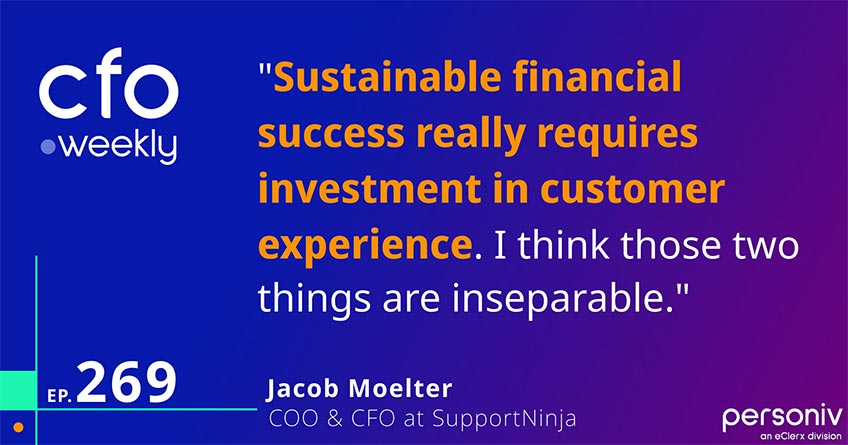
As Moelter put it, "Sustainable financial success really requires investment in customer experience. I think those two things are inseparable." - 00:02:13 - 00:04:27
AI Creates Skills Premium for Human Agents
Rather than simply replacing jobs, AI is creating higher-value opportunities for customer service professionals. Companies are using AI to handle routine tasks while upskilling teams to focus on complex, high-impact interactions that require empathy and strategic thinking.
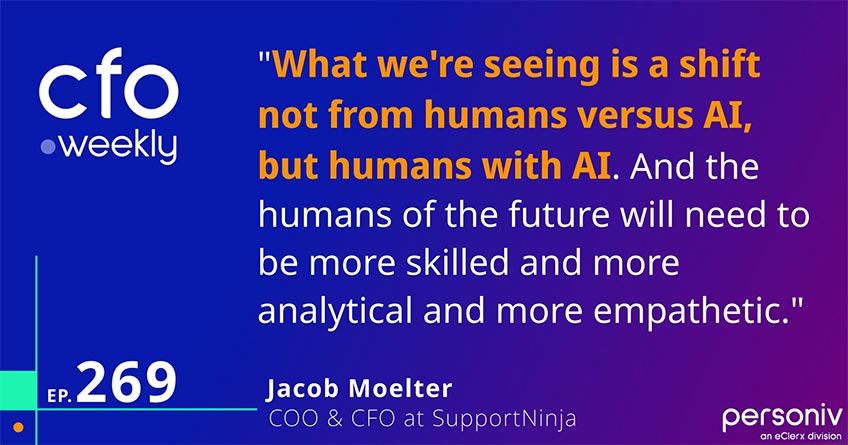
"What we're seeing is a shift not from humans versus AI, but humans with AI. And the humans of the future will need to be more skilled and more analytical and more empathetic." Moelter emphasized. - 00:07:06 - 00:08:53
Designing Hybrid AI-Human Service Models
Leading brands structure layered systems where AI handles high-volume, low-complexity tasks while humans focus on nuanced, emotionally charged interactions. CFOs play a critical role in modeling the right balance between automation and human touch to optimize both cost and customer outcomes.
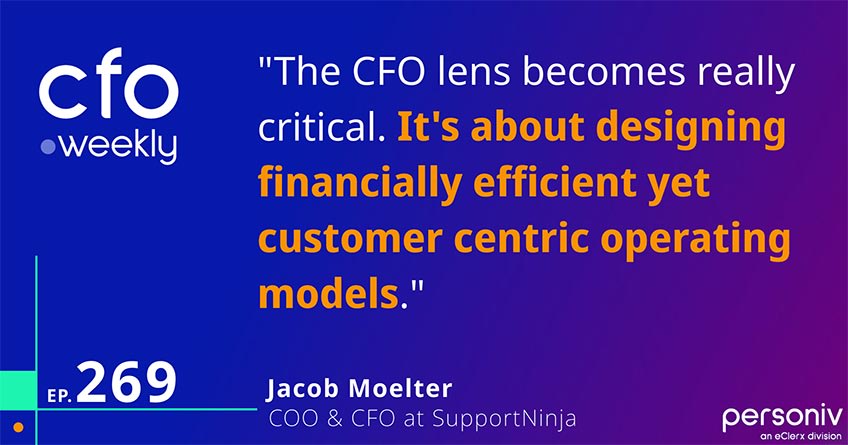
"The CFO lens becomes really critical. It's about designing financially efficient yet customer centric operating models." Moelter explained. - 00:15:57 - 00:18:31
The CFO Evolution: From Gatekeeper to Growth Architect of Customer Experience
The modern CFO role has evolved from controlling spend to ensuring every dollar invested in CX drives measurable customer outcomes and financial growth. Data capabilities now allow CFOs to directly measure how customer experience impacts retention and lifetime value.
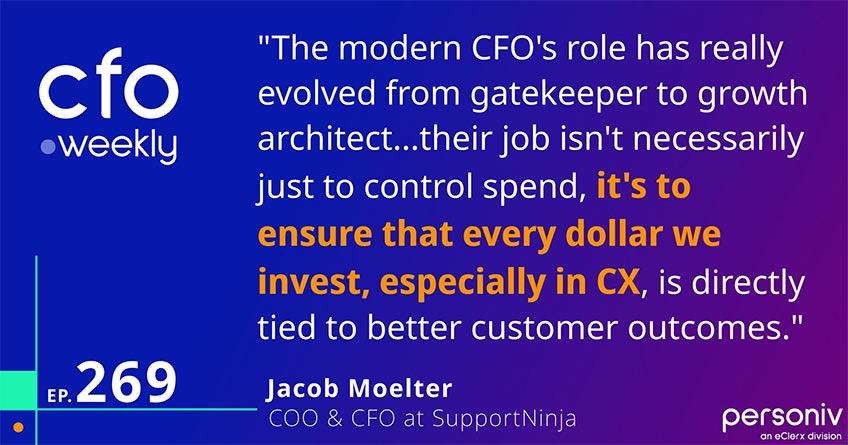
"The modern CFO's role has really evolved from gatekeeper to growth architect... their job isn't necessarily just to control spend, it's to ensure that every dollar we invest, especially in CX, is directly tied to better customer outcomes." Moelter commented - 00:18:53 - 00:20:27
Future CFO as Business Model Architect
Over the next five to ten years, CFOs will take increasingly active roles in customer experience, digital transformation, and talent strategy. Success will require storytelling with data, cross-functional collaboration, and comfort with ambiguity as finance leaders help design business models that balance efficiency, innovation, and culture.
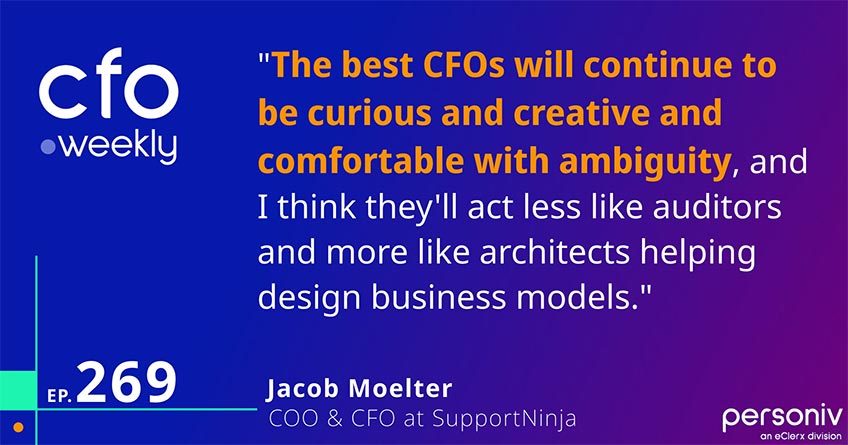
"The best CFOs will continue to be curious and creative and comfortable with ambiguity, and I think they'll act less like auditors and more like architects helping design business models." Moelter said. - 00:20:53 - 00:22:15
Want more insights? Explore our full library of podcast blogs here.
To listen to the full conversations, check us out on Apple Podcasts, Spotify, and our RSS or your favorite podcast player!
Instructions on how to follow, rate, and review CFO-Weekly are here.
Ready to turn your customer interactions into revenue? We deliver premier finance and accounting solutions tailored to help CFOs optimize customer experience and drive strategic growth. Drop us a line today to learn more.





















